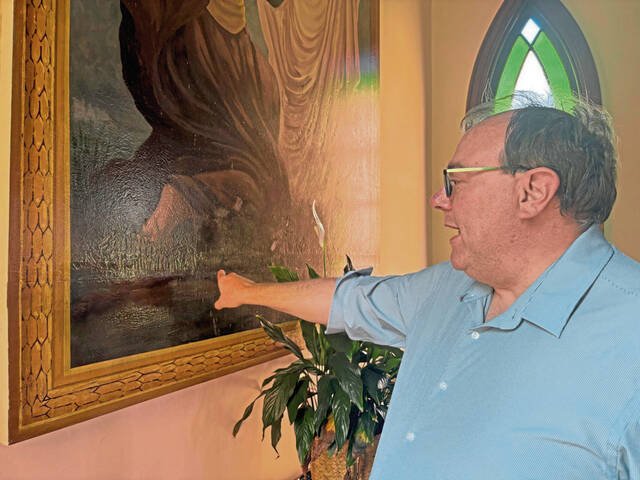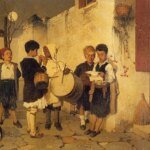
Painters dab a variety of materials onto their canvases. Oil paint. Pastel paint. Watercolor paint.
But milk paint?
“The materials relate directly to the time period,” said Michael Belman, referring to a 1930s-era painting at Emmanuel Reformed Church of the United Church of Christ in Murrysville, which he recently finished restoring.
Belman and his wife of Pittsburgh’s Squirrel Hill neighborhood own Fine Art Conservation Services, doing restoration work at smaller museums, historic sites and for private clients across the region.
Emmanuel Pastor Joseph Hedden brought Belman in to restore the painting in advance of the church’s 205th anniversary. It depicts Jesus risen from the tomb and meeting Mary Magdalene on Easter morning.
According to Belman, the religious glory inherent in the scene wasn’t exactly on display when he first laid eyes on it.
“It’s nearly 100 years old. So even though there were blues and greens and beiges, it kind of all just became slate gray over the years,” he said. “We used some chemical cleaning agents and were really able to brighten the painting and bring some of those colors back.”
But what about that milk paint?
It’s made by processing bovine milk and deriving a polymer called casein. Belman said the curious medium can be tied to the period in which the painting was created, the 1930s.
“With World War I a few years back and the build-up to World War II already under way, I think a lot of companies were looking for cheaper options than oil to make commercial paint,” he said.
While the artist is unknown, Belman said the painting was most likely created by a commercial art firm that did a good deal of work for churches in Western Pennsylvania.
“The immigrant community of Pittsburgh in the late 1800s came from very religious, heavily Catholic parts of Europe — Ireland, Germany, Yugoslavia, Hungary — and religious artwork was very prominent,” Belman said. “So when they came to the U.S., they wanted it there as well. And companies were formed which specialized in that.”
The painting is in Emmanuel’s apse, the same spot it would likely occupy in a European church, Belman said, which makes perfect sense for a church that dates to the early 19th century.
“Emmanuel is a really special place,” he said. “Everyone was very appreciative and very happy at how the restoration turned out.”
Patrick Varine is a TribLive reporter covering Delmont, Export and Murrysville. He is a Western Pennsylvania native and joined the Trib in 2010 after working as a reporter and editor with the former Dover Post Co. in Delaware. He can be reached at pvarine@triblive.com.










